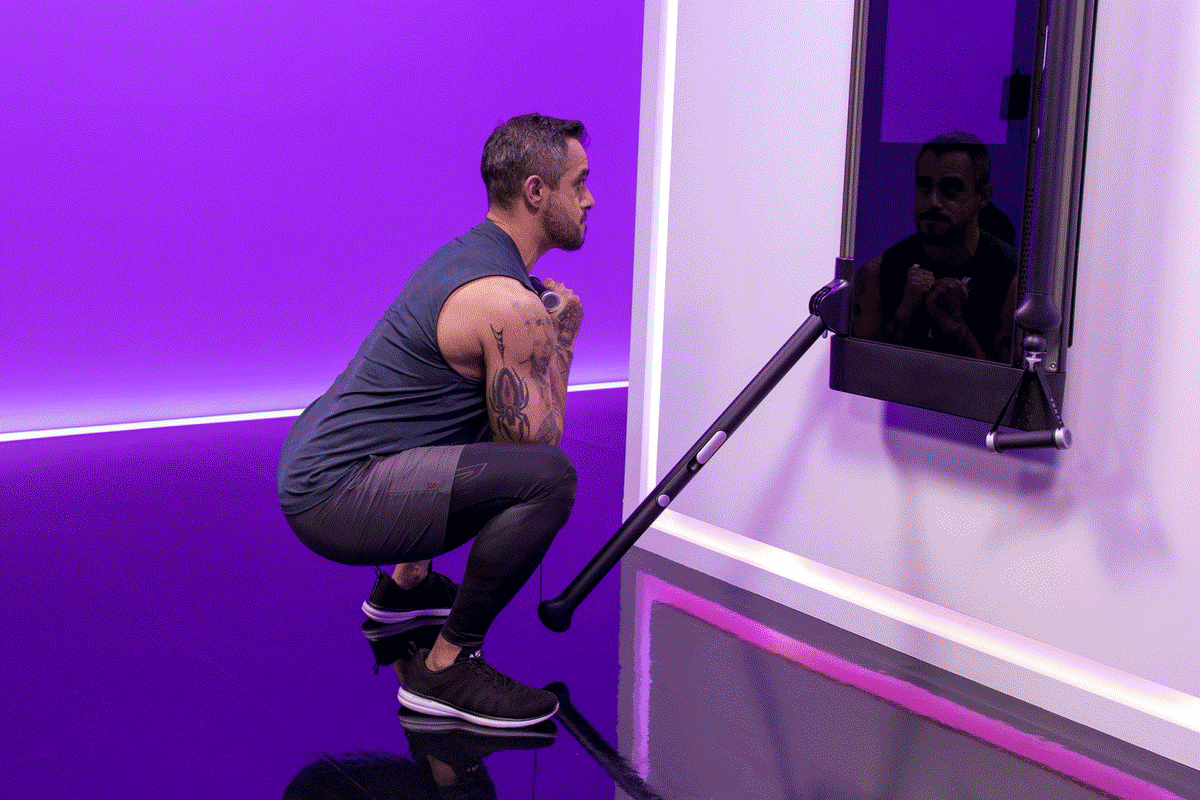When you’re ready to move into a new era of your fitness, here are the best postpartum exercises on Tonal that can get you there.

After the baby comes, there are countless new routines you need to get used to. One of them, when you’re ready, is figuring out how to return to exercise. Postpartum exercise boasts major boons for your physical and mental health as a new mom, helping you reconnect with your body and flooding you with feel-good endorphins.
“It’s like a form of self-care,” says Michelle Grabau, a new mom and Fitness Programming Director at Tonal. “A Tonal workout is something that I get to do for me when my baby is napping or even when she’s there watching. Working out postpartum is a great opportunity to model behaviors, positive body image, and a positive relationship with exercise for your child.”
That said, it’s important to ease back into movement when the time is right for you. Do your best to shrug societal pressure to “bounce back” immediately and try not to push yourself to return to your pre-pregnancy workout routine. “It’s okay for your goals to have shifted dramatically to function, to health, whatever it might be for you,” Grabau adds.
Keep in mind that your own personal pregnancy and delivery experience will dictate specific exercise guidelines, and the most important factor to consider is how you feel. Work closely with your doctor or medical team to develop your exercise plan and listen to your body to ease back into movement. Once you’re cleared for postpartum exercise, focus on engaging your deep core, rebuilding the integrity of your pelvic floor, and retraining movement patterns early on before moving into strength training workouts.
When you’re ready to start postpartum strength training, focus on low weight and high reps for the first month or two before phasing in heavier sets. Note that asymmetrically-loaded exercises are only advised once diastasis recti is healed, and it’s generally recommended that new moms wait about 12 weeks before starting more intense workouts.
To start your postpartum strength training journey, try these five postpartum exercises on Tonal—selected by Grabau and specifically designed to help you build a foundation for new strength. You’ll be ready to conquer any challenge that comes your way with your little one.

Reverse Lunge to Row
Why it works: Reconnect to your deep core and pelvic floor with total body postpartum exercises. The reverse lunge to row is asymmetrically loaded, so it challenges you to keep your balance by engaging your core. “This move is good for getting into that deep core like the transverse abdominis because you’re transferring weight across your body, from lower to upper,” notes Grabau. “It’s one of the most functional ways to strengthen your core.”
How to do it: Facing Tonal, grab the handle with your right hand, take one step back, and stand tall with the arms down at sides and handle at your hip. Step right foot back and bend both knees to lower into a lunge. As you lower, extend your arm and the handle toward Tonal. As you stand, pull the handle back to your hip. Repeat.

Half-Kneeling Lat Pull-down
Why it works: So often, you are doing something with one arm while you hold your baby on your hip with another. This postpartum exercise also challenges your unilateral strength and core stability. Using only one arm in a kneeling position, you can find and work any muscle imbalances that might be developing and make it easier to move around with a baby in one arm, explains Grabau.
How to do it: Take a handle in your right hand and get into a half kneeling position with left knee on the floor. Start with your arm extended overhead and pull the handle to the outside of your shoulder, bringing your elbow to your side. Slowly release the weight back up with control, straightening your elbow. Repeat.

Resisted Lateral Lunges
Why it works: You’re constantly bending down and picking up your baby. Postpartum exercises that target your gluteus medius with lateral movement can support your core and help re-engage your glutes so you move more efficiently and alleviate low back pain. “You’ll be supporting your pelvic floor with this movement working the glutes and adductors and you’re increasing your ability to absorb and transfer weight from one leg to another in a different direction (side to side) than you normally move,” says Grabau.
How to do it: Take the handle in your right hand and take a few large steps away from the Tonal. Stand sideways so the handle is on the far side of your body with the cable crossing in front of you. Take a wide step towards Tonal and sit back into your inside leg like you’re sitting into a chair while keeping the other leg straight. Press the floor away from you with the inside leg and return to standing and repeat on the same side.

Neutral Grip Deadlift
Why it works: During pregnancy, your posture aligns to make room for the growing baby, which means your glutes tend to lengthen and your hip flexors get tighter to accommodate the new changes. The deadlift is a foundational movement that targets muscles that may have gotten weaker during pregnancy. Your center of gravity pulls you forward when you’re pregnant, so the posterior chain tends to turn off, notes Grabau. So working the hamstrings and the glutes is really important to build back muscle balance and reverse postural changes.
How to do it: Place your feet hip width apart, bend your knees, hinge your hips back and with the handles in your hands, push through your heels to stand tall. Keep your arms and back straight throughout the entire range of motion. Repeat.

Resisted Glute Bridges
Why it works: Your baby will be crawling in no time, and you’ll want to keep up with them. Building your posterior chain with the added stability of the upper body means you can move fast without pain. Your glutes are part of your core so any type of glute bridge is going to be really supportive and help you move and feel better, explains Grabau. This is one of the best postpartum exercises in particular has an added bonus of postural control through the upper body.
How to do it: Take a handle in each hand and lie face-up on your mat with your arms extended above your chest. Place your feet hip-distance apart on the floor. Lift the hips up toward the ceiling, pressing the floor away from you and keeping your abdominals engaged. Lower the hips back down to the floor while keeping your arms stationary.
The information provided in this article is for educational and informational purposes only. Individuals with pre-existing health conditions, injuries, or concerns should consult with their healthcare provider before trying a new exercise or nutrition regimen.


